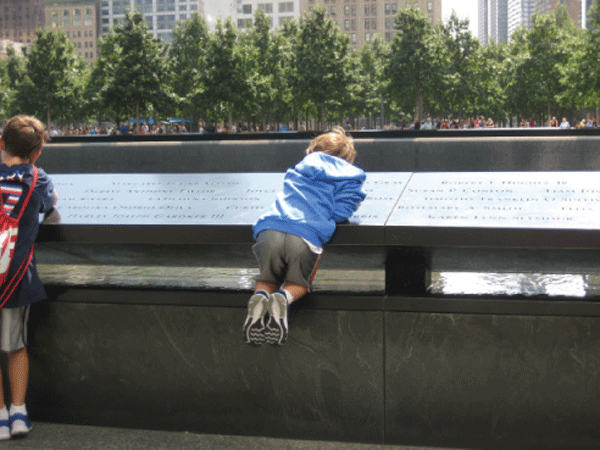Dusica Sue Malesevic Downtown Express
Californians Joe Vasco — both the second and the third— leaned back, grinned and took a photo with a selfie stick.
They were not at the Empire State Building or the Statue of Liberty, but rather in front of one of the two pools at the 9/11 Memorial.
Vasco senior said he hadn’t been to New York City in 30 years and it was the first visit for his son.
“First and foremost thing would be to come here,” he told me on a busy Tuesday afternoon last week. “Every American should come here.”
They spent four hours at the 9/11 Museum while wishing they had two days to spend on the exhibits, he said.
When asked about using a selfie stick at the site, Vasco senior said he didn’t see any negative connotations.
“I wanted to preserve this memory that we were here,” he said.
But it begs the question: Is taking smiling selfies at the 9/11 Memorial appropriate considering what the site is supposed to commemorate?
Selfies, sticks that facilitate said photos and “duck” faces are not new, but spend several hours at the memorial and you will see a preponderance of all. On the Tuesday Vasco visited with his son, I counted 14 sticks used in just one hour as I walked a loop between the two pools.
On that day, I approached each person or group using one, but almost all were visitors from other countries.
Even if a stick was not seen in action, there were plenty around. People held them like a baton as if ready to conduct a social media symphony, or in front of them like a leash. If sticks were not available, phones were turned around. Sometimes women struck model poses as if they were about to unveil a “Price is Right” showcase prize while their partner took a photo.
The memorial has several rules that govern the site, including no smoking, but nothing about selfies.
Their rules state the memorial and museum “are places of solemn reflection dedicated to honoring and remembering the tragic events and the overwhelming loss of innocent life that occurred at this location and others on September 11, 2001 and February 26, 1993. Given the unique nature of the site and the tragedy that occurred here, proper decorum, personal behavior, and conduct is required from all visitors at all times in order to provide the entire visiting public with respect, and an equal opportunity to have an enriching and meaningful experience.”
Officials with the memorial declined to comment for this article.
When the attack happened 14 years ago this Friday, cell phone technology was burgeoning, but one still had to press a number button three times to get a desired letter for a text. In 2004, when a plan for the site was chosen, Facebook had just started and the first iPhone was three years away.
For many, the compulsion to document every moment is strong. But what do we lose when we can’t stop to reflect at the reflecting pools? Does the meaning of the memorial get lost in the shuffle when people are focused on taking photos?
Still, there were people who poured over the names etched in bronze. A man held his coffee cup and just stood a few moments looking at the pool. A father told his son what the names represent.
For Michael Burke, who lost his brother, Captain William Burke of Engine 21, on September 11, there is nothing at the site to remind people of the attacks. Physical reminders, such as Koenig‘s “Sphere” that was once at the plaza in front of the World Trade Center, are not at the site.
“You’re denied the opportunity to confront the attacks where they happened,” Burke said in a phone interview. “What the memorial has inspired is not somber reflection, remembrance — it’s happy selfies.”
Burke said people should be able to have whatever reaction they want. However, he said he has seen wedding pictures being taken, a young group of men flashing gang signs and happy couples canoodling while snapping a shot.
“A selfie stick in and of itself I guess is pretty harmless,” he said. “But they might as well as be at Rockefeller Center or Times Square.”



